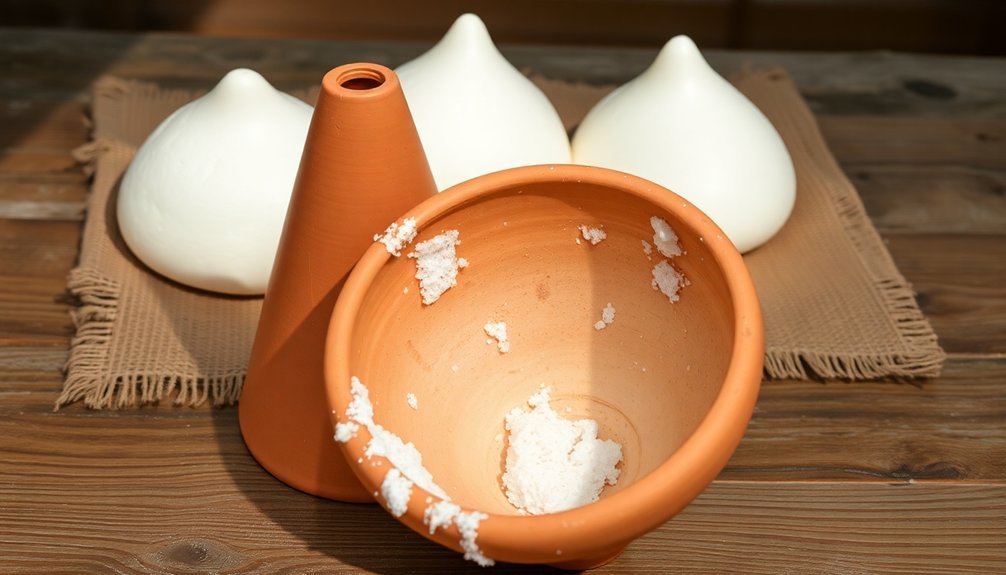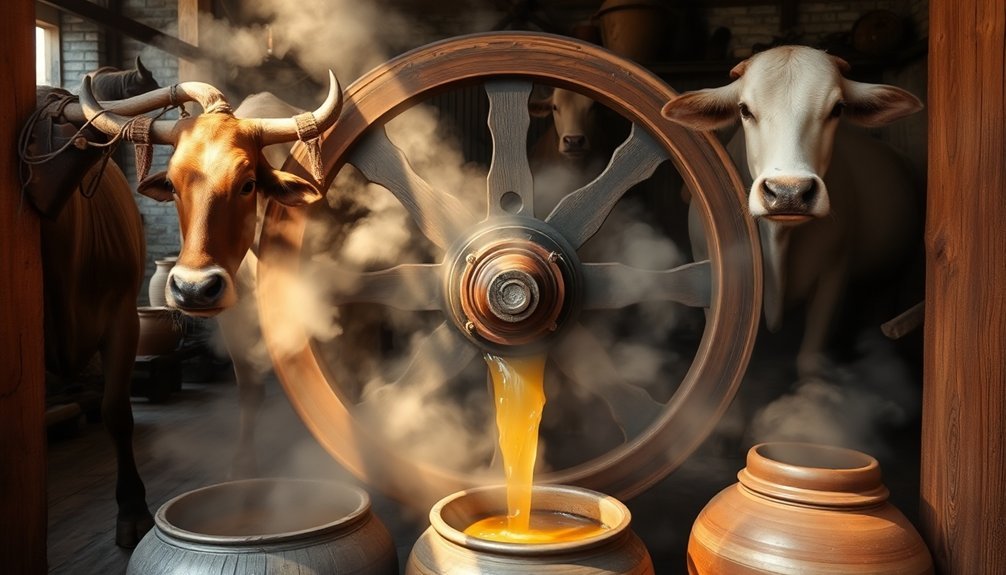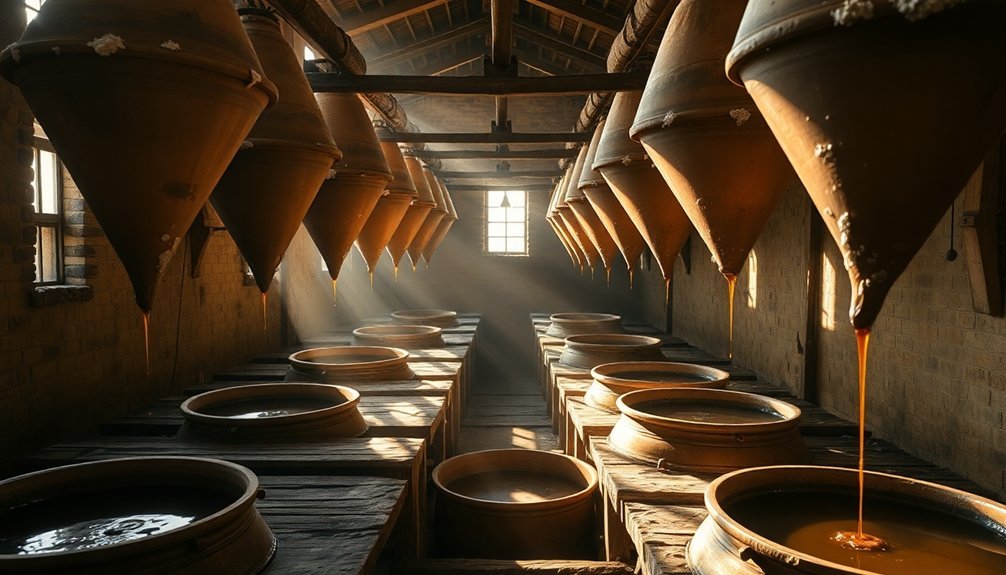Historic sugar curing transformed raw cane juice into refined white sugar through several key steps you'd recognize from the 8th to 19th centuries. After crushing the cane in mills, you'd boil the juice until it crystallized into cone-shaped loaves. You'd then use clay filtration to separate the brown molasses, which dripped through holes at the bottom. To achieve pure white sugar, you'd apply a clay-water mixture that washed away impurities as it seeped through the loaves. Each refinement cycle brought the sugar closer to the prized white crystals that became symbols of wealth and sophistication in European markets.
The Ancient Sugar Loaf Process

Over several days, you'd see the sugar crystallize into a solid cone-shaped mass known as a sugar loaf, while the brown molasses separated and dripped through the bottom hole.
After the loaves dried completely, you'd remove them from the molds and trim them into their final shape for storage and transport.
This method, which reached Europe in the 1400s from the Middle East, proved particularly effective for long-distance trade since the solid sugar loaves were easier to transport than liquid forms. The process became especially refined in Amsterdam, where fifty to sixty refineries operated by 1660, dominating the European sugar market.
Molasses Separation Through Clay Filtration
Throughout the sugar refining process, clay filtration emerged as a critical technique for separating molasses from crystallized sugar. You'll find that workers would apply a porridge-like clay mixture to the base of sugar loaves, creating a controlled system for water flow that helped extract the molasses while preserving the valuable sugar crystals.
When you examine the mechanics of this process, you'll see that water poured over the clay mixture would slowly seep through, making the molasses fluid enough to drip out through a small hole at the cone's tip. This careful regulation prevented excessive sugar dissolution, as the clay's consistency determined how much water passed through the crystallized sugar mass. Modern Durco pressure leaf filters have since replaced these traditional methods.
While you might think this method was perfect, it actually required multiple steps to achieve high purity. You'd often need to re-cook the molasses to extract remaining sugar, and the sugar itself would undergo several refinement cycles.
Workers would also use additional clarifying agents like egg whites, cow's blood, or limed water to improve the final product. Though time-consuming, this clay filtration method represented a significant advancement in sugar processing technology.
Sugar Mill Crushing Methods

The evolution of sugar processing extended beyond filtration to the fundamental task of extracting juice from sugarcane stalks. If you'd visited an early sugar mill, you'd have seen either animals or enslaved laborers powering vertical rollers that crushed the cane. Before mills existed, early inhabitants chewed raw cane to extract its sweet juice.
These mills used three fluted cylinders, each 30-40 inches long, with adjustable spaces between them using cross keys and wedges.
You'll find that wind and water power later emerged as alternatives, reducing labor demands while keeping mills running almost constantly during harvest. Though these power sources improved operations, they didn't greatly enhance juice extraction efficiency.
The real breakthrough came with steam power in the late 18th century. You'd have noticed a dramatic shift by the 1830s, particularly in Louisiana, where more than half the mills operated on steam.
These mills featured horizontal cylinders arranged triangularly and used cane carriers for feeding.
In 1849, you'd have seen another leap forward with Bessemer's steam-operated crusher. His innovative design featured pressing cylinders with drainage holes and a vertical hopper.
This machine could extract 600 gallons of juice hourly, delivering 20% more efficiency than traditional wooden rollers.
Mediterranean Sugar Production Origins
During the early 8th century, Muslims introduced sugar cane to Egypt, marking the beginning of Mediterranean sugar production. You'll find that sugar's journey actually started in eastern Asia, moved to India, then Persia, before Islamic civilization brought it westward. By the year 1000, Egypt had become a major sugar producer, maintaining its dominance until around 1350.
As you trace sugar's Mediterranean expansion, you'll see that Arabs spread sugar cane across Northern Africa to Morocco and Spain during the 7th century. They didn't stop there – by the early 800s, they'd introduced sugar to Cyprus, Crete, and Sicily.
Morocco's sugar industry flourished between 1000 and 1200, while the Iberian Peninsula's production boomed from 1300 to 1500.
The Islamic civilization didn't just spread sugar cane; they revolutionized its processing. You'll find their influence in the refined technologies they developed, which came from India and Southeast Asia. They transformed sugar production into a large-scale industry, creating various sugar qualities for export.
This technology later spread to new regions like Madeira and the Canary Islands, shaping the future of sugar production.
Sugar Whitening Techniques

Ancient sugar makers employed intricate whitening techniques to transform raw brown sugar into pure white crystals. They'd begin by placing crude sugar in conical containers with holes at the bottom, allowing molasses to naturally drain away. This initial separation was essential for achieving a cleaner product.
The most innovative step in their process involved applying a thick clay and water mixture to the top of the sugar cone. As water slowly dripped through the sugar mass, it would wash away remaining molasses and impurities, leaving behind progressively whiter crystals. Unlike modern methods, they didn't use chemical bleaches, relying instead on this natural washing process.
Once the sugar reached the desired whiteness, you'd find workers carefully removing the loaves from their molds and placing them on drying racks. They'd trim the dried sugar loaves to their final shape before wrapping them in paper.
The end result was a highly valued white sugar that symbolized wealth and refinement in European markets. This labor-intensive process, while time-consuming, produced remarkably pure sugar that maintained its quality during storage and transport.
Frequently Asked Questions
How Did Weather Conditions Affect Sugar Curing in Different Geographical Regions?
You'll find weather had minimal direct impact on sugar curing across regions, but it greatly affected crop yields, labor conditions, and processing timing. Rain could disrupt harvesting and slow down production considerably.
What Alternative Materials Were Used When Clay Wasn't Available for Filtration?
When you couldn't find clay, you'd use charcoal, bone char, or sand for filtering sugar. You could also rely on textiles like cloth and hemp, or try mineral substances including lime and alum.
How Long Did Sugar Loaves Typically Last in Storage?
You'll find that sugar loaves could last almost indefinitely when stored properly. If you kept them in cool, dry conditions away from moisture, they'd maintain their quality for months or even years without degrading.
What Tools Were Used to Maintain Precise Temperature Control During Boiling?
You'll need a reliable candy thermometer to monitor boiling points at 212°F sea level. You should adjust for altitude and watch sugar concentration stages to achieve specific textures during the cooking process.
How Did Transportation Methods Influence the Location of Sugar Curing Facilities?
You'll find most sugar facilities were built near waterways since water transport was cheaper and more efficient than land routes. Coastal and river locations made it easier to ship raw materials and finished products.
In Summary
You've now learned how historic sugar production relied heavily on labor-intensive processes, from crushing raw cane to creating cone-shaped sugar loaves. You understand how clay filtration helped separate molasses and how Mediterranean traders first developed many refining techniques. Whether you're studying food history or just curious about sugar making, these ancient methods show how far we've come in sweetener production.





Leave a Reply